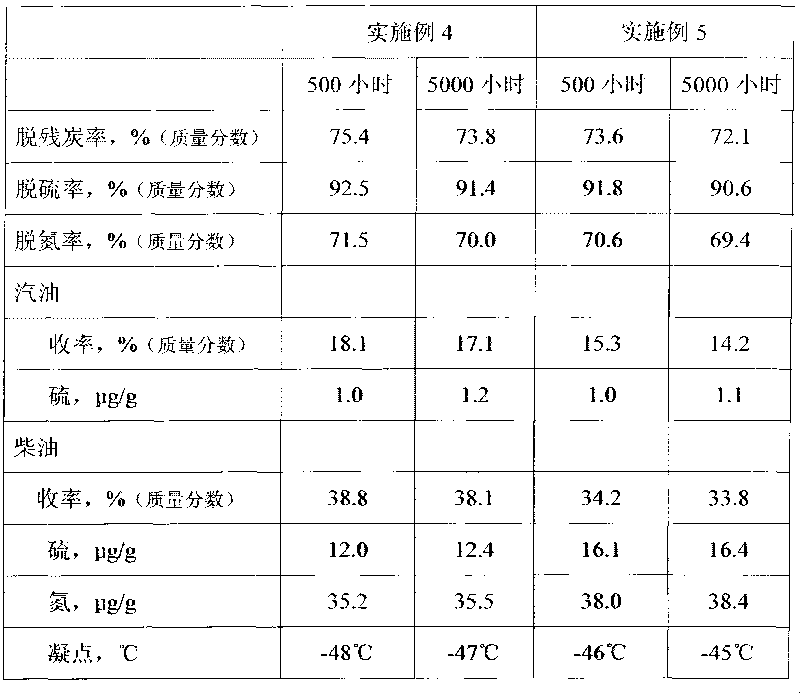Method for hydrogenating ethylene tar
A technology of ethylene tar and processing method, which is applied in the fields of hydrotreating process, petroleum industry, and hydrocarbon oil treatment, etc. It can solve the problems that the ethylene tar fraction cannot be processed and has not been effectively processed, so as to achieve safe and stable operation and avoid temperature rise Excessively high, the effect of prolonging the operating cycle
- Summary
- Abstract
- Description
- Claims
- Application Information
AI Technical Summary
Problems solved by technology
Method used
Image
Examples
Embodiment 1~3
[0045] The properties of the light and heavy fractions of ethylene tar used are shown in Table 2 and Table 4. Example The ethylene tar light fraction is treated by a series process. Two reactors are used. The first reactor is equipped with a hydrogenation protection agent FZC-103 and a hydrofining catalyst 3936, and the upper part of the second reactor is filled with a hydrogenation carbon removal catalyst HDC. -3. The first hydrocracking catalyst loaded in the middle is a hydrocracking catalyst containing amorphous silica-alumina and Y molecular sieve, and the second hydrocracking catalyst loaded in the lower part is a hydrocracking catalyst containing amorphous silica-alumina and β molecular sieve . In the embodiment, the volume ratio of FZC-103:3936:HDC-3:first hydrocracking catalyst:second hydrocracking catalyst is as follows: 12:13:13:31:31. The results of the reaction are shown in Table 3. In addition, the device has been operated for 5,000 hours, and the distribution ...
Embodiment 4
[0055] The heavy fraction of ethylene tar (see Table 4 for properties) passes through the hydrogenation protection catalyst, the hydrogenation deresidue catalyst and the hydrogenation conversion catalyst in sequence, and its volume ratio is 8:55:37, wherein the hydrogenation protection catalyst used is FZC-100 and FZC-102B, its volume ratio is 1: 2, the hydrogenation conversion catalyst such as the catalyst obtained in CN02109422.5 Example 1 is recorded as ZH1, and its properties are shown in Table 5.
[0056] Table 5 Composition and properties of hydroconversion catalyst
[0057]
[0058] The loading volume ratio of the used hydrodecarbonization catalyst HDC-1 and HDC-2 is 4:6. The loading order of the hydrogenation catalyst for the heavy fraction of ethylene tar is as follows: FZC-100, FZC-102B, HDC-1, HDC-2, ZH1. In this example, the process conditions for the hydrogenation of heavy fractions are as follows: the reaction pressure is 16MPa, the reaction temperatur...
Embodiment 5
[0060] Compared with Example 4, the loading volume ratio of the hydrodecarbonization catalysts HDC-1 and HDC-2 used was changed to 5:5, and the rest were the same as Example 4.
[0061] Table 6 Heavy fraction hydrogenation results
[0062]
PUM
| Property | Measurement | Unit |
|---|---|---|
| specific surface area | aaaaa | aaaaa |
| specific surface area | aaaaa | aaaaa |
| diameter | aaaaa | aaaaa |
Abstract
Description
Claims
Application Information
 Login to View More
Login to View More - R&D
- Intellectual Property
- Life Sciences
- Materials
- Tech Scout
- Unparalleled Data Quality
- Higher Quality Content
- 60% Fewer Hallucinations
Browse by: Latest US Patents, China's latest patents, Technical Efficacy Thesaurus, Application Domain, Technology Topic, Popular Technical Reports.
© 2025 PatSnap. All rights reserved.Legal|Privacy policy|Modern Slavery Act Transparency Statement|Sitemap|About US| Contact US: help@patsnap.com

